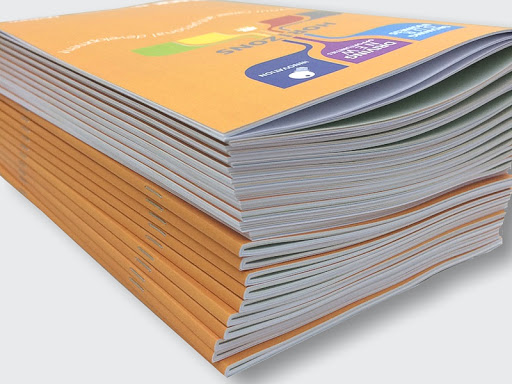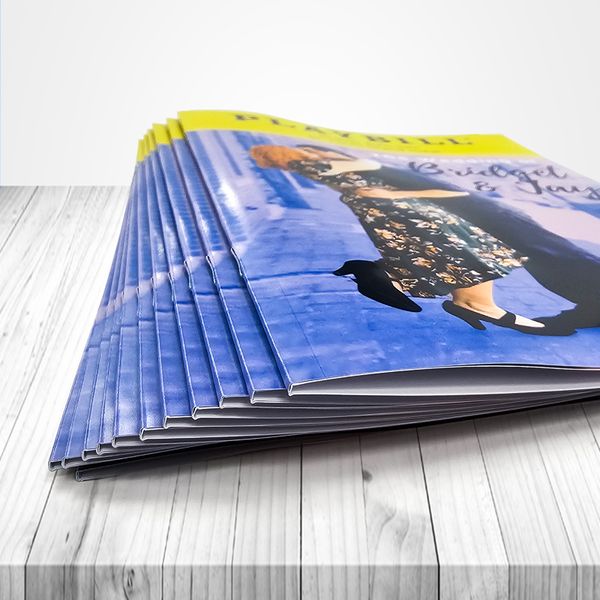The Most Common Mistakes to Avoid in Your Booklet Printing Design
The Most Common Mistakes to Avoid in Your Booklet Printing Design
Blog Article
The Important Overview to Comprehending Pamphlet Printing Options and Techniques
The procedure of brochure printing includes multiple factors to consider that can greatly affect the end product. From picking the suitable format and size to understanding the subtleties of binding methods, each choice plays a crucial duty. Furthermore, elements such as paper supply and printing methods more affect the efficiency of the booklet. As one browses these choices, it ends up being imperative to realize exactly how they interconnect and what that suggests for the general end result.
Recognizing Booklet Dimensions and layouts
When thinking about booklet printing, recognizing the different layouts and sizes available is essential for accomplishing the desired presentation. Brochures can be created in countless styles, consisting of saddle-stitched, spiral-bound, and perfect-bound, each offering distinct benefits. Typical dimensions range from typical letter (8.5 x 11 inches) to smaller alternatives like A5 (5.8 x 8.3 inches), enabling flexibility based upon content and target audience.Selecting the proper dimension can affect both the design and viewers engagement. Larger dimensions could fit aesthetically driven material, while smaller sized formats may be extra portable and user-friendly. Additionally, the variety of pages impacts the option of binding technique, as thicker brochures may require tougher bindings. Ultimately, understanding these aspects allows for a much more customized technique, guaranteeing that the last item aligns with the designated message and visual, enhancing the general efficiency of the communication.
Choosing the Right Paper Stock

Binding Techniques: Factors To Consider and alternatives
When it comes to binding techniques for pamphlets, several choices are offered, each with distinctive benefits. Saddle stitch binding provides a cost-efficient solution for thinner brochures, while best binding methods give a more polished seek thicker magazines. Wire-O binding attracts attention for its sturdiness and convenience of use, making it ideal for files that need versatility.
Saddle Stitch Binding
Saddle stitch binding offers a economical and functional solution for assembling booklets, making it a popular option among services and authors. This binding approach entails folding sheets of paper in fifty percent and stapling them along the fold line, developing a well organized and cool appearance. Normally appropriate for brochures with a lower web page count, saddle stitching is perfect for magazines, brochures, and educational products. The simplicity of this strategy permits fast production and is usually preferred for promotional products or brief runs. However, it is important to note that saddle stitch binding might not appropriate for thicker brochures, as the spine may not hold up under raised weight. Overall, it continues to be a reliable option for several printing jobs.
Perfect Binding Techniques
Perfect binding is an extensively made use of strategy that supplies a professional and sleek surface to publications and pamphlets. This technique entails gluing the pages together at the back using a solid adhesive, enabling a tidy side and the capability to hold a bigger number of web pages compared to saddle stitching. Perfect binding is particularly ideal for thicker brochures, such as magazines and annual records, where a sturdy, level spine is wanted. Additionally, it uses the alternative for a printed cover that can be made to improve aesthetic appeal. Factors to consider such as web page count, paper weight, and the intended use of the brochure must be taken into account, as they can influence longevity and general high quality.
Wire-O Binding Choices
Wire-O binding, understood for its sturdiness and flexibility, offers a superb option for brochures that call for very easy web page transforming and a specialist look. This binding technique employs a series of metal loops that hold pages securely, enabling them to exist level when open. It is specifically ideal for magazines, manuals, and presentations due to its durable nature. Wire-O binding is readily available in numerous shades and sizes, suiting various web page counts and thicknesses. In addition, it allows the incorporation of covers and tabs, enhancing the booklet's total aesthetic. Considerations for Wire-O binding consist of the selection of cable color, the dimension of the loops, and the level of personalization desired, all of which can profoundly affect the end product's look and performance.
Digital vs. Offset Printing: Which Is Best for You?
When selecting a printing method for pamphlets, comprehending the differences in between electronic and offset printing is essential. Digital printing makes use of contemporary technology to create premium prints quickly and cost effectively, making it suitable for short runs or tasks calling for fast turn-around times. It permits for customization, offering the capability to print on-demand with very little waste.In contrast, balance out printing is a standard approach article that stands out in generating big amounts with constant top quality. It involves moving ink from a plate to a rubber blanket, after that to the paper, which leads to vivid colors and specific details. Counter printing typically calls for longer setup times and is extra cost-efficient for bigger volumes.Ultimately, the choice between digital and balance out printing depends on task requirements, budget plan, and wanted quantity. For small, time-sensitive jobs, electronic could be the most effective choice, while offset may be better for larger, premium manufacturings.

Designing Your Brochure: Tips and Best Practices
When designing a booklet, careful focus to layout, font option, and shade use can significantly boost its performance. A well-structured format guides the visitor's eye, while ideal fonts assure readability and communicate the preferred tone. In addition, effective use shade can stimulate emotions and highlight vital information, making the overall design more impactful.
Picking the Right Design
How can one effectively pick the right format for a pamphlet? First, it is necessary to evaluate the pamphlet's purpose and target audience. A tidy, organized format boosts readability and interaction. Making use of a grid system can help in straightening aspects consistently, developing a specialist appearance. In addition, incorporating aesthetic hierarchy with varying dimensions and positionings of pictures and text can guide the visitor's eye and stress vital info. It is additionally important to leave enough white space, which protects against overcrowding and permits far better focus. Lastly, evaluating various layouts with mock-ups can give insight into just how the design executes in real-world scenarios, guaranteeing that the end product meets both aesthetic and useful demands.
Picking Appropriate Typefaces
An appropriate font can considerably improve the total layout of a booklet, complementing the layout and reinforcing the content's message. The choice of typefaces must take into consideration readability, specifically for body message, as it assures the information comes to all readers. Sans-serif fonts are typically liked for digital styles, while serif fonts can lend a conventional feel in printed products. It's suggested to limit font options to two or three to keep aesthetic comprehensibility. Furthermore, font dimension plays an essential role; headings should be distinctive yet not frustrating, while body text need to be comfy for reading. When choosing typefaces, positioning with the pamphlet's motif and target market is essential for efficient interaction and visual charm.
Efficient Use Color
Color works as a powerful device in brochure layout, forming understandings and guiding visitor feelings. It can evoke feelings of exhilaration, depend on, or calmness, depending on the tones selected. Designers ought to take into consideration color theory concepts, ensuring that the selected scheme straightens with the booklet's message and target audience. As an example, utilizing cozy shades like red and orange can create urgency, while cooler tones like environment-friendly and blue foster tranquility.Additionally, contrast plays a crucial duty; corresponding colors can enhance readability and visual charm. Consistency in shade use across web pages even more reinforces brand identification and communication. Eventually, reliable shade execution not only catches interest however likewise strengthens the brochure's function, making it a necessary element of successful style.
Completing Touches: Coatings and Unique Impacts
While numerous take into consideration the content and format of a pamphlet one of the most essential components, the completing touches, such as coatings and special effects, play an important function in improving its general charm. Coatings can supply security and sturdiness, guaranteeing that the booklet withstands damage. Matte finishes offer an innovative, non-reflective surface area, while shiny layers can make shades show up more vivid and attractive. Special results, like embossing or foil stamping, add a responsive dimension that can produce a memorable impact. These strategies can highlight particular locations, accentuating essential details or creating visual passion. Additionally, UV layer can provide a high-shine finish that elevates the overall look.Together, these ending up touches not their website only improve the pamphlet's aesthetic but likewise connect expertise and interest to information, inevitably leaving a lasting influence on the viewers.
Expense Factors To Consider for Brochure Printing
Comprehending the different cost factors to consider for booklet printing is essential for companies and businesses aiming to optimize their budget plans. Trick factors influencing prices consist of the choice of paper, ink, and binding techniques. Better materials, such as superior paper or specialized inks, typically raise the general cost. Furthermore, the dimension and page matter of the this content booklet play a substantial role; bigger brochures need even more sources and time to produce.Another vital consideration is the printing technique, whether digital or countered, as each has its own prices framework and suitability for various amounts. Businesses must additionally factor in style costs, which can vary based upon intricacy and making use of expert services. Eventually, shipping and handling costs can add to the overall, particularly for big orders. By examining these components, companies can make educated choices that straighten with their economic abilities while accomplishing the preferred quality in their printed products.
Frequently Asked Questions
What Are the Environmental Impacts of Pamphlet Printing?
The ecological effects of booklet printing consist of logging from paper production, carbon emissions from transportation, and waste generation from thrown out products - Booklet Printing. Sustainable techniques, such as using recycled paper and environmentally friendly inks, can reduce these effects
Just How Can I Ensure Color Precision in My Brochure?
To guarantee shade accuracy in a booklet, one must make use of adjusted monitors, use expert color accounts, conduct examination prints, and choose high-grade printing solutions that offer shade matching and proofing choices for finest results.
What Is the Typical Turnaround Time for Booklet Printing?
The normal turnaround time for pamphlet printing varies relying on the complexity and amount - Booklet Printing. Normally, it ranges from a couple of days to two weeks, affected by factors such as publishing methods and completing needs
Are There Minimum Order Quantities for Pamphlet Printing?

Can I Publish Pamphlets in Multiple Languages?
Publishing booklets in numerous languages is possible. Lots of printing solutions supply alternatives for multilingual or multilingual layouts, permitting efficient communication. Mindful preparation guarantees that design elements fit different languages without jeopardizing readability or appearances. In addition, factors such as paper stock and printing techniques further influence the effectiveness of the booklet. When considering pamphlet printing, recognizing the numerous layouts and dimensions offered is crucial for attaining the wanted discussion. When selecting a printing technique for brochures, comprehending the differences in between electronic and counter printing is vital. Furthermore, the size and web page matter of the brochure play a considerable function; bigger booklets require even more sources and time to produce.Another important factor to consider is the printing strategy, whether digital or offset, as each has its very own prices structure and viability for different quantities. The environmental impacts of pamphlet printing consist of deforestation from paper manufacturing, carbon discharges from transportation, and waste generation from thrown out materials.
Report this page